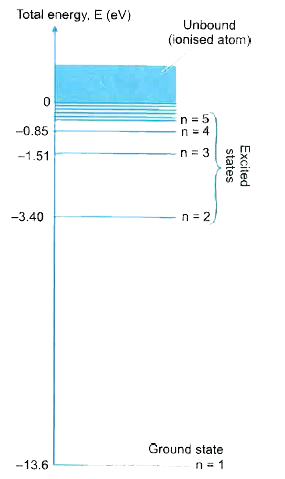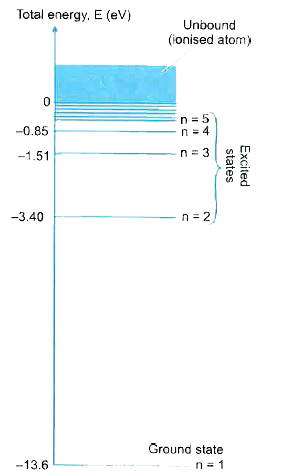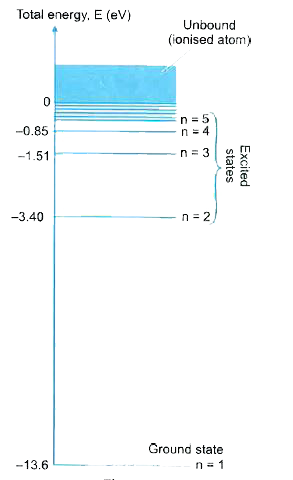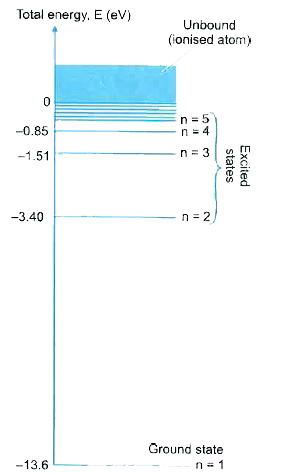phtoelectron are emitted when 4000A0 radiation is incident on a surface of work fuction 1.9eV. these photoelectrons pass through a region has a- particles to form He+ ion, emitting a single photon in this process He+ ions thus formed are in their fourth excited state.
Energy released during during the combination of He+ ions is
5.38eV
3.38eV
2.38eV
1.38eV
The correct Answer is:B
Differences of energy photoelectron recombines with a particle =1.18−(−2.2)=3.38eV
Topper's Solved these Questions
- ATOMIC PHYSICSBook:NARAYNAChapter:ATOMIC PHYSICSExercise:NCERT Based Questions
Explore 24 Videos
- ATOMIC PHYSICSBook:NARAYNAChapter:ATOMIC PHYSICSExercise:LEVEL-V
Explore 51 Videos
- ATOMIC PHYSICSBook:NARAYNAChapter:ATOMIC PHYSICSExercise:LEVEL-II (C.W)
Explore 16 Videos
- ALTERNATING CURRENTBook:NARAYNAChapter:ALTERNATING CURRENTExercise:LEVEL - II(H.W)
Explore 13 Videos
- ATOMS Book:NARAYNAChapter:ATOMS Exercise:EXERCISE -4
Explore 47 Videos
Similar Questions
Photoelectrons are emitted when 400 nm radiation is incident on a surface of work - function 1.9 eV. These photoelectrons pass through a region containing a-particles. A maximum energy electron combines with an a -particle to from a He+ ion, emitting a single photon in this process. He+ ions thus formed are in their fourth excited state. Find the energies in eV of the photons lying in the 2 to 4 eV range, that are likely to be emitted during and after the combination. [Take,h=4.14×10−15eV−s]
View Solutionphotoelectrons are emited when 40nm radiation is incident on a surface of work function 1.9eV These photoelectron pass tjhrough a ragain cotaining a - particle A maximum energy electron conbines with an a - particle to from a He+ ion emitting a single photon in this process He+ ions thus formed are in their fourth excited state find the energies in eV of the photons typing is the 2 to 4eV rage, that are likrly to be emitted during and after the combiution [Takeh=4014×10−15eVs]
View Solution
Knowledge Check
photoelectron are emitted when 4000A0 radiation is incident on a surface of work fuction 1.9eV. these photoelectrons pass through a region has a- particles to form He+ ion, emitting a single photon in this process He+ ions thus formed are in their fourth excited state.
Energy of the fourth excited state is approxA−4.2eVB−2.2eVC−3.2eVD−1.2eVphtoelectron are emitted when 4000A0 radiation is incident on a surface of work fuction 1.9eV. these photoelectrons pass through a region has a- particles to form He+ ion, emitting a single photon in this process He+ ions thus formed are in their fourth excited state.
Energy of emitted photon in range of 3eV & 4eV after combination isA3.86eVB3.24eVC3.29eVD5.24eVWhen the light of wavelength 400nm is incident on a metal surface of work function 2.3eV, photoelectrons are emitted. A fasted photoelectron combines with a He2+ ion to form He+ ion in its third excited state and a photon is emitted in this process. Then the energy of the photon emitted during combination is
A4.2eVB5.7eVC6.5eVD6.8eV
An electron joins a helium nucleus to form He+. Find the wavelength of the photon emitted in this process (in nm) if the electron is assumed to have no kinetic energy when it combines with nucleus. Assume Bhor's nodel to be applicable.
View SolutionRead the pasage given below as well as the adjoining energy level diagram and then answer the questions given after the passage .
As per Bohr's theory og hydrogen atom the energy of an atom in a state corresponding to principal quantum number n is given as :
En=−13.6n2eV
The energy of an atom is the least when its electron is revolving in an orbit closets to the nucleus i.e., the one for which n =1. This state is called the ground state. When a hydrogen atom receives energy by processes such as electron collision , the atom may acquire sufficient energy to raise the electron to higher energy states and the atom is then said to be in an excited state . From these excited states the electron can then fall back to a state of lower energy , emitting a photon in the process.
The energy level diagram for the stationary states of a hydrogen atom , compouted from Bohr's relation for energy , is given in Fig.12.02. The principal quantum number n labels the stationary states in the ascending order of energy . Obviously , the highest energy corresponds to n=∞ and has an energy of 0 eV. This is the energy of the atom when the electron is completely removed (r=∞) from the nucleus and is at rest.

Now answer the follwoing questions:
When does a hydrogen atom emit a photon ?
View SolutionRead the pasage given below as well as the adjoining energy level diagram and then answer the questions given after the passage .
As per Bohr's theory og hydrogen atom the energy of an atom in a state corresponding to principal quantum number n is given as :
En=−13.6n2eV
The energy of an atom is the least when its electron is revolving in an orbit closets to the nucleus i.e., the one for which n =1. This state is called the ground state. When a hydrogen atom receives energy by processes such as electron collision , the atom may acquire sufficient energy to raise the electron to higher energy states and the atom is then said to be in an excited state . From these excited states the electron can then fall back to a state of lower energy , emitting a photon in the process.
The energy level diagram for the stationary states of a hydrogen atom , compouted from Bohr's relation for energy , is given in Fig.12.02. The principal quantum number n labels the stationary states in the ascending order of energy . Obviously , the highest energy corresponds to n=∞ and has an energy of 0 eV. This is the energy of the atom when the electron is completely removed (r=∞) from the nucleus and is at rest.

Now answer the follwoing questions:
Name the spectral series of hydrogen atom observed in visible light region.
View SolutionRead the pasage given below as well as the adjoining energy level diagram and then answer the questions given after the passage .
As per Bohr's theory og hydrogen atom the energy of an atom in a state corresponding to principal quantum number n is given as :
En=−13.6n2eV
The energy of an atom is the least when its electron is revolving in an orbit closets to the nucleus i.e., the one for which n =1. This state is called the ground state. When a hydrogen atom receives energy by processes such as electron collision , the atom may acquire sufficient energy to raise the electron to higher energy states and the atom is then said to be in an excited state . From these excited states the electron can then fall back to a state of lower energy , emitting a photon in the process.
The energy level diagram for the stationary states of a hydrogen atom , compouted from Bohr's relation for energy , is given in Fig.12.02. The principal quantum number n labels the stationary states in the ascending order of energy . Obviously , the highest energy corresponds to n=∞ and has an energy of 0 eV. This is the energy of the atom when the electron is completely removed (r=∞) from the nucleus and is at rest.

Now answer the follwoing questions:
How can a hydrogen atom receive energy to raise the electron to higher energy states ?
View SolutionRead the pasage given below as well as the adjoining energy level diagram and then answer the questions given after the passage .
As per Bohr's theory og hydrogen atom the energy of an atom in a state corresponding to principal quantum number n is given as :
En=−13.6n2eV
The energy of an atom is the least when its electron is revolving in an orbit closets to the nucleus i.e., the one for which n =1. This state is called the ground state. When a hydrogen atom receives energy by processes such as electron collision , the atom may acquire sufficient energy to raise the electron to higher energy states and the atom is then said to be in an excited state . From these excited states the electron can then fall back to a state of lower energy , emitting a photon in the process.
The energy level diagram for the stationary states of a hydrogen atom , compouted from Bohr's relation for energy , is given in Fig.12.02. The principal quantum number n labels the stationary states in the ascending order of energy . Obviously , the highest energy corresponds to n=∞ and has an energy of 0 eV. This is the energy of the atom when the electron is completely removed (r=∞) from the nucleus and is at rest.

Now answer the follwoing questions:
What does negative value of atomic energy signify?
View Solution

